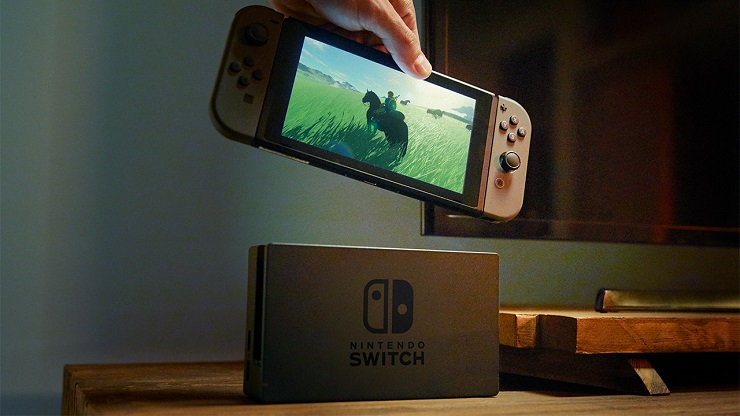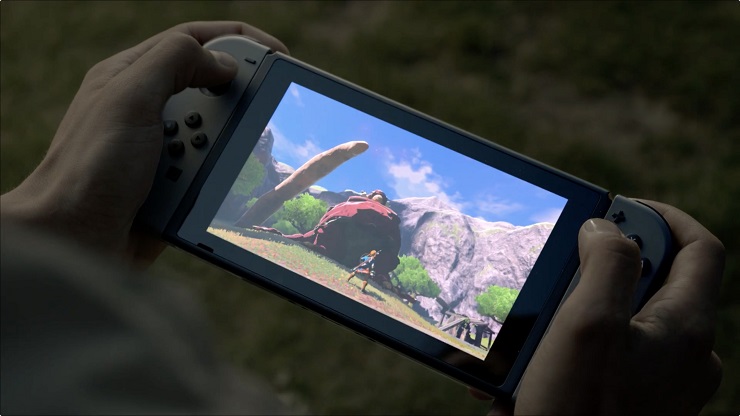What the Nvidia Shield can tell us about Nintendo Switch
The Nintendo Switch reveal was Nintendo at its most Nintendo; here’s what it looks like, here’s what it does, and then, like an overzealous cartoon pig bursting through a bass drum, th-th-th-th-that’s all folks, we’ll see you in a few months!
Nintendo knows to keep people’s interest you give away just enough so appetites are fully whetted, but not quite enough to leave the customer sated. Letting the consumer dream up all the fantastical possibilities of what the console could be capable of will always trump the reality when it comes to marketing.
Despite not giving much away, many of us have already played the Nintendo Switch in one form or another, or at least, more aptly, its younger lesser-known cousin, the Shield.
It’s common knowledge the Switch is powered by a custom Tegra processor, the same processor seen in the Nvidia line of Shield devices. Think of the Tegra chip as an all-in-one superchip which hosts the CPU and GPU that results in a high-end mobile gaming experience. It’s worth noting, a Tegra chip isn’t designed to go head-to-head with PC, Xbox One, or PlayStation 4. If you’re expecting something similar to the current console offerings, then the Switch isn’t for you. If, however, you see the potential of mobile as a platform to rival current-gen, and want to see just how far the boundaries can be pushed, then you’ve come to the right place.
To get an idea of what is and isn’t possible on Switch, we need to look to the Shield. For the sake of ease, we’ll be focusing on the Shield Tablet K1 and the Shield Android TV Box for our answers. After all, the Switch is both of these in one: A mobile tablet and a TV console.
Both Shield devices are powered by Tegra technology. There’s a lot of tech-speak to explain what the chip is capable of, but tangible examples here offer more insight. The Shield can run Borderlands 2 and Borderlands: The Pre-sequel, Metal Gear Solid: Revengeance, and Doom 3 to name a few. All of which is within an Android operating system. The Switch, on the other hand, has been seen to run Skyrim, Splatoon, Mario Kart 8, and a host of other Nintendo titles. Anyone who owned a Wii U knows how proficient Nintendo is when it comes to pulling as much power as possible out of a console with lower-than-current-gen specifications. Nvidia was able to create a mobile phone environment capable of running Xbox 360 quality games. Nintendo, conversely, is capable of running the frankly stunning Mario Kart 8 on tech that much lesser than its rivals. In terms of visuals, it’d be easy to presume the Switch could rival – and possibly surpass – what’s already been seen on the Wii U.
The Shield devices also have another trick up their sleeve – one Nvidia isn’t likely to dig too deeply into: Emulation. Having tested this myself, the Shield TV box (and the tablet, although I’ve not tested out the tablet compatibility firsthand) is capable of emulating certain Wii titles. So far I’ve played around with retro consoles – NES, SNES, Mega-Drive, N64, etc. – as well as later consoles like the PlayStation Portable, Dreamcast, GameCube, and Wii. There’s varying compatibility in the later generations, but a surprising amount of titles work without problem. Loco Roco on the big screen looks, and plays, phenomenally, by the way.
[Note: All games tested on the Shield were titles I own.]
Why all the talk of powerful emulation? Nintendo hasn’t laid out plans for how they’ll serve up previously-released titles, but understanding how the Tegra chip works, and what it’s capable of, means emulation of past hardware is definitely achievable on Switch.
Another area worth looking at is Nvidia’s Netflix-like streaming service GeForce Now, which lets users stream PC games at full-spec via an internet connection to the Shield. We’re getting into hopeful speculation here so strap in.
Nintendo would be foolish not to make use of this technology – either Nvidia’s or something made from scratch. Nintendo wants money. What better way than to have a PS Now-style subscription service featuring access to the last 30 years of Nintendo’s biggest hits? People love emulation, people love playing retro, the tech’s there, the Switch can make this a reality – it’s time for Nintendo to catch up with what gamers want: New and old.
The Switch is a chance for Nintendo to right the wrongs of the Wii U. A chance to give a clear message, to show gamers the new system is worthy of their time and money. It’s easy to point fingers whenever Nintendo falls: No first-party support! A gimmicky machine! Nintendo must hate gamers!
The truth is, Nintendo just isn’t cool anymore. Adults went on to grown-up games. Kids want either Skylanders, Lego, or Call of Duty. Mario has become the unpopular guy at school. He’s probably lovely, but he’s kind of weird, hangs out by himself, doesn’t want anyone to play with him.
Mario is the Nokia phone in a world ruled by Apple, the Kinect to the VR, the Ouya to literally anything else. But with the Switch, with the high-end mobile gaming experience, the House of M has a chance to become relevant again. Everyone has a phone, everyone games on the go, the Switch is for those people, the people who want to play Borderlands 2 on their TV and in the bath. The people who want to slice skulls in Revengeance while they’re on the bus. The people, who whether we like to admit it or not, are the biggest gaming demographic on the planet.
If Nintendo is taking inspiration from the Shield, then Mario may just find himself with some new friends come March.







